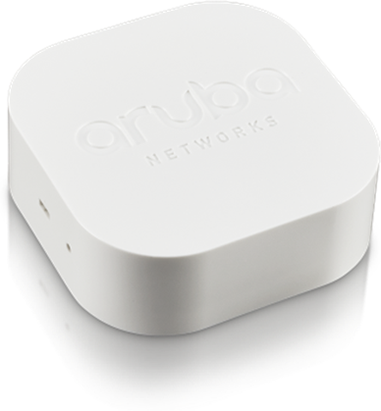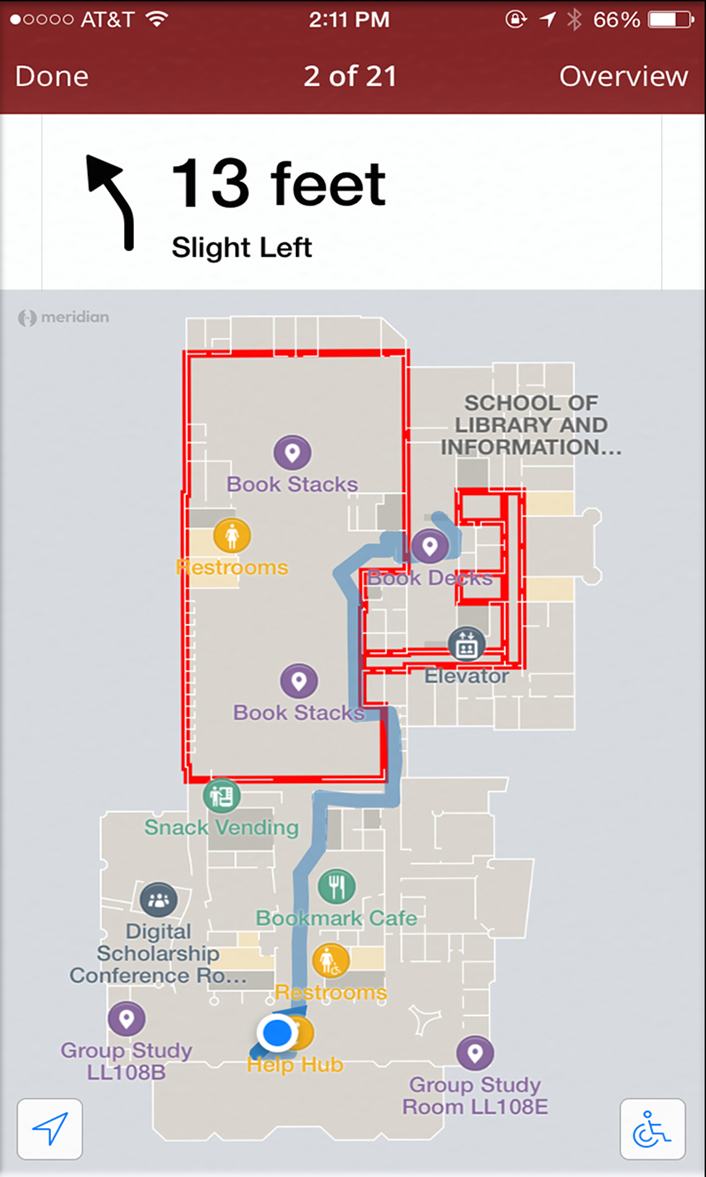Key Takeaways
- To help users navigate reimagined library spaces and resources, the University of Oklahoma libraries investigated the possibilities inherent in the Internet of Things, specifically whether a beacon could serve their purpose.
- The resulting beacon-based NavApp guides students to resources, study spaces, technology, and services within the library.
- Further infrastructure development will position the university for future initiatives that benefit the student experience.
With the Internet of Things (IoT), as with other technologies before it, usefulness does not magically emerge from implementing new technology; rather, it is the culmination of a comprehensive plan for merging technical know-how with business knowledge or user-generated content. The University of Oklahoma libraries applied this comprehensive approach in looking for a way to help users navigate its renovated spaces and resources. At the same time it experimented with the IoT, testing whether a beacon could serve the desired purpose.
Innovation @ the Edge
Under the leadership of Dean Richard Luce, the University of Oklahoma libraries have undergone a massive transformation over the past two years. Luce envisioned the libraries serving as the intellectual crossroads of the university — the primary campus hub for faculty, staff, and student interaction — by offering collaborative spaces, open access to tools and technologies, and thought-provoking programming that would bring people together to share and refine ideas. As part of this initiative, Luce founded Innovation @ the Edge, a technology-infused academic laboratory focused on experimentation and providing OU's community with access to cutting-edge technologies such as 3D printing tools, custom virtual reality workstations, and microelectronics kits.
In 2014, the team behind Innovation @ the Edge began investigating how beacons could be used to guide students to library exhibits and resources. Their effort sits at the logical nexus of mobility, campus Wi-Fi, and next-generation mapping technologies, coupled with content curation. The last part cannot be stressed enough, said University of Oklahoma CIO Loretta Early:
"Without useful content, you may have an interesting technical capability, but you will be missing the boat because you won't have engaged users."
This video demonstrates the resulting Navigation App (NavApp) in use. The library team used beacon technology to create the app, which makes the libraries more accessible to faculty, staff, and students. NavApp was recently recognized with a national award by Campus Technology for innovation in emerging technologies.
Matt Cook on NavApp
I sat down with Emerging Technologies Librarian Matt Cook to discuss his journey into the Internet of Things, his goals for the project, and some of his lessons learned. An excerpt from our discussion follows.
How did the idea to use beacons in the library come about?
To many of our 4,000-plus incoming freshman, navigating an academic library (with more than five million volumes and almost a half-million square feet of facility space) is a daunting task. The idea of beaconing the library, then, stemmed from a desire to simplify an extraordinarily large and complex physical space that — while replete with services and resources — isn't necessarily approachable to first-time users or the undergrads who represent our target demographic.
What technologies did you use?
We used a combination of hardware and software to deploy the NavApp. On the software side, the Meridian CMS provided a streamlined set of building maps and the ability to generate virtual "placemarks" on those maps to link physical resources to searchable terms within the mobile app. To guide users to these physical resources, Bluetooth low-energy (BLE) beacons were spread throughout Bizzell Library, as well as the Galileo's World galleries, to pinpoint to within a meter accuracy the location of the user indoors, a lá Google Maps. See figure 1.

Figure 1. A Bluetooth low-energy beacon
How many resources did the initiative consume? Was it hard to get a pilot off the ground?
The financial cost of the NavApp proof of concept was reasonable and required partial time allocations from a handful of FTEs, and hardware costs (e.g. the beacons themselves) were very low; maintenance of the tool has yet to require the addition of a full-time employee. Thankfully, OU's Digital Initiative [http://www.ou.edu/oneuniversity.html] helped us fund some of the initial start-up software and hardware costs. We began exploring indoor navigation technology in mid-2014, and our proof-of-concept deployment — using Aruba/Meridian BLE beacons — took place in the spring of 2015, so it was about six months from conceptual design to our phase 1 deployment.
What does the beaconing technology currently do, and what is your vision for the future?
Currently, beacon tech allows users to navigate vast physical spaces to within a meter accuracy and find locations, service points, technology, etc. within those spaces. Moreover, digital resources can be linked to physical locations via beacon technology (figure 2), which means the user experience can be augmented with a host of tutorials, videos, etc. based on location.

Figure 2. Screen capture of NavApp
What top three things would you say are critical to a successful beaconing initiative?
- Be sure your Wi-Fi infrastructure is ready to support an abundance of smartphones being used simultaneously.
- Dedicate a budget to marketing/branding so your innovative beacon tech doesn't get overlooked.
- Partner with a variety of campus entities to achieve the greatest variety of content and content types.
Up Next
So what's next for OU? We plan to continue building on the foundation we've established, expanding our experiments to the broader campus and delivering the best student experience possible. We continue to invest in our network because we are certain it will be a core infrastructure component for whatever new technology emerges, including as part of the IoT. We will continue to foster a culture of experimentation in the interest of preparing our students for the workforce of tomorrow. Already on the horizon are investments to leverage embedded sensors for parking, explore the use of beacons for time tracking, and expand our advanced technology spaces so that students can get hands-on experience with tools such as laser cutters and 3D printing.
While the final destination is not yet in sight, the journey is well underway. We anticipate fruitful discoveries and deployment of useful new tools throughout the trip, wherever it may take us.
Innovation at the University of Oklahoma
At the University of Oklahoma, innovation is a multi-year journey with a focus on student services and a destination yet to be determined. This journey began with several strategic decisions at the turn of the century, when OU, like many universities across the country, made significant investments in technology modernization, shuttering our legacy mainframe in favor of modern enterprise systems, upgrading our network, and exploring new classroom technologies.
Our president's commitment to "keep going" was codified in the summer of 2012 with the launch of the One University Digital Initiative [http://www.ou.edu/oneuniversity/store]. The Digital Initiative has sponsored several initiatives, including:
- A hands-on Technology Store where OU and K–12 students can interact with cutting-edge technologies such as Google Nexus and 3D Printing.
- Mobile applications that have streamlined university business processes to help students with on-boarding and navigating university life.
- One-to-one iPad initiatives for select programs so that every student in the course can have the same technology experience.
- Technology-infused active learning classrooms to facilitate collaborative teaching and learning.
- Digital textbook initiatives to lower the cost of attendance.
To support these efforts OU has acquired critical tools for single sign-on, data analysis, and high-density Wi-Fi. These tools will provide OU with the infrastructure for future innovation around the student user experience.
Eddie Huebsch is associate vice president for Information Technology at the University of Oklahoma.
© 2016 Eddie Huebsch. This EDUCAUSE Review article is licensed under Creative Commons BY-NC-ND 4.0 International.
